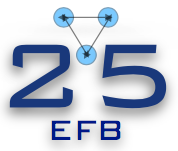Speaker
Description
The system consisting of positronium ($\rm Ps$) and antihydrogen ($\bar{\rm H}$) atoms is known to exist in only one bound state of the positronium hydride (${\bar{\rm H}\rm Ps}$) which is a hybrid atomcule that possesses both atomic and molecular properties. $\bar{\rm H}\rm Ps$ cannot be formed in purely 2-body $\bar{\rm H} + \rm Ps$ collisions, but it can be obtained when $\rm Ps$ collides with the antihydrogen ion $\bar{\rm H}^+$
$\hskip 39mm \bar{\rm H}^+ + {{\rm{Ps}}} \rightarrow \bar{\rm H}\rm Ps +e^+ \hskip 38 mm(1)$
whereby the binding energy is conveyed to the ejected positron. This collision presents a 5-body problem that we reduce to the 4-body problem and solve exactly using the technique of Gaussian Expansion Method (GEM) combined with the coupled rearrangement channels (CRC) method. The scattering matrix $S$ and the cross sections are obtained from the coupled, non-local integro-differential equations that explicitly couple all open channels. The distinctive novel feature of our approach is the simultaneous use of several Jacobi sets of coordinates in the expansion of the multi-channel wave functions. That allows efficient and rigorous treatment of the scattering cross sections.
We present the so far unknown cross sections for the collisional rearrangement reaction (1) that depletes ${\rm H}^+$ ions and results in the $\bar{\rm H}\rm Ps$ molecules.
The interest in the above collisions (1) stems from the fact that the $\bar{\rm H}^+$ ions are amenable to sympathetic cooling and, after photo-detachment of one positron, result in ultra-cold antihydrogen atoms that are to be used in ballistic experiments testing the gravitational interaction between matter and antimatter. The ongoing GBAR experiment at CERN [1] works on the production of $\bar{\rm H}^+$ ions in $\bar{\rm H} + \rm Ps \rightarrow \bar{\rm H}^+ +e^-$ collisions (the cross sections for this process have been recently calculated in our work [2]). In this context reaction (1) is a scavenging process that depletes the newly formed $\bar{\rm H}^+$ ions that pass the positronium target chamber.
The cross sections for the rearrangement (eq. 1 or its charge comjugate) have not been calculated before and there are no experimental data. High accuracy theoretical results are hence important and timely as to aid and guide the experiments. We present the cross sections for the rearrangemet (1), the concomitant elastic scattering, and the reverse process $\bar{\rm H}\rm Ps + e^+ \rightarrow \bar{\rm H}^+ +Ps$. We discuss the near-threshold features of the scattering cross sections and show that they comply with the expected behaviour stipulated by the Wigner’s law. We also visualize, via the probability density plots, the mechanism of the rearrangement reaction (1) whereby ${\rm H}^+$ shrinks and gets more tightly bound by capturing the electron, while the positron carries away the excess of energy.
[1] P. Indelicato et al. Hyperfine Interact. 228, 141 (2014).
[2] T. Yamashita, Y. Kino, E. Hiyama, S. Jonsell and P. Froelich, Phys. Rev. A 105, 052812 (2022).

